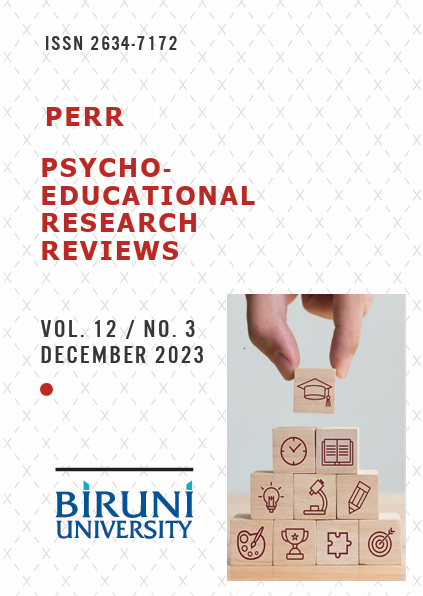Effects of an 8-Week Relational Cultural Intervention on Female University Students’ Attitudes Towards Dating Violence, Conflict Resolutions and Relationships
DOI:
https://doi.org/10.52963/PERR_Biruni_V12.N3.07Keywords:
Dating Violence, Relationship, PreventionAbstract
The aim of this research is to determine the effect of the Relational Cultural Theory Based Psycho-Education Program (RCTPP) on the attitudes of university students toward dating violence (DV), relationship qualities, and conflict resolution styles. The research is an experimental study conducted with female university students. There are nine students in the experimental group and nine students in the control group. The eight-session RCTPP developed by the researcher was applied to the experimental group. No intervention was made in the control group. As a result of the research, it was determined that the variance between the pre-test and post-test scores of the individuals in the experimental group and the control group regarding the attitude towards DV, the negative conflict resolution style (NCRS), and the compliance conflict resolution style (CCRS) differed significantly from each other. Accordingly, it was determined that the participants' attitude scores towards DV decreased, that is, they considered DV as less acceptable in relationships. In addition, it was found that the participants tended to use the NCRS and CCRS less. It was determined that the program did not affect the decrease of withdrawal conflict style scores (WCRS) in conflict resolution, and the increase in positive conflict resolution style scores (PCRS) and relationship quality scores.
Downloads
References
Adler‐Baeder, F., Kerpelman, J. L., Schramm, D. G., Higginbotham, B., & Paulk, A. (2007). The impact of relationship education on adolescents of diverse backgrounds. Family Relations, 56(3), 291-303. https://doi.org/10.1111/j.1741-3729.2007.00460.x
Amoakohene, M. I. (2004). Violence against women in Ghana: a look at women's perceptions and review of policy and social responses. Social Science & Medicine, 59(11), 2373-2385. https://doi.org/10.1016/j.socscimed.2004.04.001
Antle, B. F., Sullivan, D. J., Dryden, A., Karam, E. A., & Barbee, A. P. (2011). Healthy relationship education for dating violence prevention among high-risk youth. Children and Youth Services Review, 33(1), 173-179. https://doi.org/10.1016/j.childyouth.2010.08.031
Ball, B., Kerig, P. K., & Rosenbluth, B. (2009). Like a family but better because you can actually trust each other. Health Promotion Practice, 10, 45S-58S. https://doi.org/10.1177/1524839908322115
Balsam, K. F., & Szymanski, D. M. (2005). Relationship quality and domestic violence in women's same‐sex relationships: the role of minority stress. Psychology of Women Quarterly, 29(3), 258-269. https://doi.org/10.1111/j.1471-6402.2005.00220.x
Bonache, H., Ramírez-Santana, G., & Gonzalez-Mendez, R. (2016). Conflict resolution styles and teen dating violence. International Journal of Clinical and Health Psychology, 16(3), 276-286. https://doi.org/10.1016/j.ijchp.2016.03.003
Bonomi, A. E., Anderson, M. L., Nemeth, J., Bartle-Haring, S., Buettner, C., & Schipper, D. (2012). Dating violence victimization across the teen years: Abuse frequency, number of abusive partners, and age at first occurrence. BMC Public Health, 12(1), 637. https://doi.org/10.1186/1471-2458-12-637
Capaldi, D. M., Knoble, N. B., Shortt, J. W., & Kim, H. K. A. (2012). Systematic review of risk factors for intimate partner violence. Partner Abuse, 3(2), 231-280. https://doi.org/10.1891/1946-6560.3.2.231
Christensen, A., & Shenk, J. L. (1991). Communication, conflict, and psychological distance in nondistressed, clinic, and divorcing couples. Journal of Consulting and Clinical Psychology, 59(3), 458. https://doi.org/10.1037/0022-006x.59.3.458
Chung, D. (2005). Violence, control, romance, and gender equality: Young women and heterosexual relationships. In Women's Studies International Forum, 28(6), 445-455. https://doi.org/10.1016/j.wsif.2005.09.005
Cornelius, T. L., & Resseguie, N. (2007). Primary and secondary prevention programs for dating violence : A review of the literature. Aggression and Violent Behavior, 12, 364–375. https://doi.org/10.1016/j.avb.2006.09.006
Demirtaş, E. (2015). Flört ilişkisi olan üniversite öğrencileri arasında psikolojik saldırganlığa başvurma: toplumsal, ebeveyne ilişkin ve kişisel faktörlerin etkileşimi (Yayımlanmamış Doktora Tezi). Orta Doğu Teknik Üniversitesi, Ankara, Türkiye.
Exner-Cortens, D., Eckenrode, J., & Rothman, E. (2013). Longitudinal associations between teen dating violence victimization and adverse health outcomes. Pediatrics, 131, 71-8. https://doi.org/10.1542/peds.2012-1029
Fincham, F. D., Cui, M., Braithwaite, S., & Pasley, K. (2008). Attitudes toward intimate partner violence in dating relationships. Psychological Assessment, 20, 260–269. https://doi.org/10.1037/1040-3590.20.3.260
Foshee, V. A., Linder, F., MacDougall, J. E., & Bangdiwala, S. (2001). Gender differences in the longitudinal predictors of adolescent dating violence. Preventive Medicine, 32(2), 128-141. https://doi.org/10.1006/pmed.2000.0793
Fruzzetti, A. E., & Levensky, E. R. (2000). Dialectical behavior therapy for domestic violence: Rationale and procedures. Cognitive and Behavioral Practice, 7(4), 435-447. https://doi.org/10.1016/s1077-7229(00)80055-3
Furman, W., & Shaffer, L. (2003). The role of romantic relationships in adolescent development. In P. Florsheim (Ed.). In Adolescent Romantic Relations and Sexual Behavior. Mahwah, NJ: Erlbaum, pp. 17-36.
Furr, S. R. (2000). Structuring the group experience: A format for designing psychoeducational groups. The Journal for Specialists in Group Work, 25(1), 29-49. https://doi.org/10.1080/01933920008411450
Gala, J., & Kapadia, S. (2013). Romantic relationships in emerging adulthood: A developmental perspective. Psychological Studies, 2013, 58(4), 406-418. https://doi.org/10.1007/s12646-013-0219-5
Giordano, P. C., Soto, D. A., Manning, W. D., & Longmore, M. A. (2010). The characteristics of romantic relationships associated with teen dating violence. Social Science Research, 39(6), 863-874. https://doi.org/10.1016/j.ssresearch.2010.03.009
Hammond, W. R., & Yung, B. R. (1991). Preventing violence in at-risk African-American youth. Journal of Health Care for the Poor and Underserved, 2(3), 359-373. https://doi.org/10.1353/hpu.2010.0341
Hira, S. N., & Overall, N. C. (2011). Improving intimate relationships: Targeting the partner versus changing the self. Journal of Social and Personal Relationships, 28(5), 610-633. https://doi.org/10.1177/0265407510388586
Hooper, D., Coughlan, J., & Mullen, M. (2008). Structural equation modeling: Guidelines for determining model fit. Electronic Journal of Business Research Methods, 6(1), 53-60.
Jaffe, P. G., Sudermann, M., Reitzel, D., & Killip, S. M. (1992). An evaluation of a secondary school primary prevention program on violence in intimate relationships. Violence and Victims, 7(2), 129-146. https://doi.org/10.1891/0886-6708.7.2.129
Josephson, W. L., & Proulx, J. B. (2008). Violence in young adolescents' relationships: A path model. Journal of Interpersonal Violence, 23(2), 189-208. https://doi.org/10.1177/0886260507309340
Kerpelman, J. (2010). The youth build USA evaluation study of Love Notes...Making relationships work for young adults and young parents. Retrieved from https://www.dibbleinstitute.org/Documents/YBUSA-Love-Notes-Evaluation-report-2010.pdf
Lanz, M., & Tagliabue, S. (2007). Do I really need someone in order to become an adult? Romantic relationships during emerging adulthood in Italy. Journal of Adolescent Research, 22(5), 531-549. https://doi.org/10.1177/0743558407306713
Lavoie, F., Vezina, L., Piche, C., & Boivin, M. (1995). Evaluation of a prevention program for violence in teen dating relationships. Journal of Interpersonal Violence, 10(4), 516-524. https://doi.org/10.1177/088626095010004009
Leaf, S., Cascardi, M., O'Leary, K. D., & Cano, A. (1997). Efficacy of a dating violence prevention program on attitudes justifying aggression. Journal of Adolescent Health, 21, 11−17. https://doi.org/10.1016/s1054-139x(96)00309-6
Lundquist, E., Hsueh, J., Lowenstein, A. E., Faucetta, K., Gubits, D., Michalopoulos, C., & Knox, V. (2014). A family-strengthening program for low-income families: Final impacts from the Supporting Healthy Marriage evaluation. MDRC.
Luthra, R., & Gidycz, C. A. (2006). Dating violence among college men and women: Evaluation of a theoretical model. Journal of Interpersonal Violence, 21(6), 717-731. https://doi.org/10.1177/0886260506287312
Miller, S., Williams, J., Cutbush, S., Gibbs, D., Clinton-Sherrod, M., & Jones, S. (2015). Evaluation of the Start Strong initiative: preventing teen dating violence and promoting healthy relationships among middle school students. Journal of Adolescent Health, 56(2), 14-19. https://doi.org/10.1016/j.jadohealth.2014.11.003
Navaro, L. (2012). Tapınağın öbür yüzü: Kadınlar ve erkekler üzerine. Varlık Yayınları.
Nazlı, S. (2016). Kapsamlı gelişimsel rehberlik programı (Rev. 5th ed.). Anı Yayıncılık.
O'Leary, K. D., Woodin, E. M., & Fritz, P. A. (2006). Can we prevent the hitting? Recommendations for preventing intimate partner violence between young adults. Journal of Aggression, Maltreatment, Trauma, 13(3-4), 121-178. https://doi.org/10.1300/j146v13n03_06
Özabacı, N. (2011). İlişki Niteliği Ölçeği'nin Türkçe uyarlaması: Geçerlik ve güvenirlik çalışması. Education and Science/Egitim ve Bilim, 36(162), 159-167. http://egitimvebilim.ted.org.tr/index.php/EB/article/view/774/318
Özcebe, H., Aslan, D., Karabiber, A. H., Küçüköztaş, M. F., Oransay, K., & Ölmez, İ. (2002). Bir grup üniversite öğrencisinin flört şiddeti konusundaki görüşleri. Toplum ve Sosyal Hizmet, 13(1), 20-28. https://dergipark.org.tr/en/download/article-file/797326
Özen, A., Engin, S. S., & Uğurlu, N. S. (2016). Conflict resolution styles scale in romantic relationship: The validity and reliability study. Nesne Psikoloji Dergisi, 4(7), 1-19. http://dx.doi.org/10.7816/nesne-04-07-01
Ro, E., & Lawrence, E. (2007). Comparing three measures of psychological aggression: Psychometric properties and differentiation from negative communication. Journal of Family Violence, 22(7), 575-586. https://doi.org/10.1007/s10896-007-9109-8
Shorey, R. C., Cornelius, T. L., & Bell, K. M. (2008). Behavioral theory and dating violence: A framework for prevention programming. The Journal of Behavior Analysis of Offender and Victim Treatment and Prevention, 1(4), 1. https://doi.org/10.1037/h0100452
Shorey, R. C., Zucosky, H., Brasfield, H., Febres, J., Cornelius, T. L., Sage, C., & Stuart, G. L. (2012). Dating violence prevention programming: Directions for future interventions. Aggression and Violent Behavior, 17(4), 289-296. https://doi.org/10.1016/j.avb.2012.03.001
Toplu-Demirtaş, E., & Hatipoğlu-Sümer, Z. (2011). Flört ilişkisinde şiddetin yaygınlığı ve türleri. XI. Ulusal Psikolojik Danışma ve Rehberlik Kongresi. Retrieved from https://www.pegem.net/akademi/kongrebildiri_detay.aspx?id=133693.
Wolfe, D. A., Wekerle, C., Scott, K., Straatman, A., Grasley, C., & Reitzel-Jaffe, D. (2003). Dating violence prevention with at-risk youth: A controlled outcome evaluation. Journal of Consulting and Clinical Psychology, 71, 279−291. https://doi.org/10.1037/0022-006x.71.2.279
Woodin, E. M., & O’Leary, K. D. (2010). A brief motivational intervention for physically aggressive dating couples. Prevention Science, 11(4), 371-383. https://doi.org/10.1007/s11121-010-0176-3
World Health Organization (2010). Preventing intimate partner and sexual violence against women: Taking action and generating evidence. Geneva: World Health Organisation and London School of Hygiene and Tropical Medicine. Retrieved from https://www.who.int/violence_injury_prevention/publications/violence/9789241564007_eng.pdf
Additional Files
Published
How to Cite
Issue
Section
License
Copyright (c) 2023 Psycho-Educational Research Reviews

This work is licensed under a Creative Commons Attribution-NonCommercial-NoDerivatives 4.0 International License.










